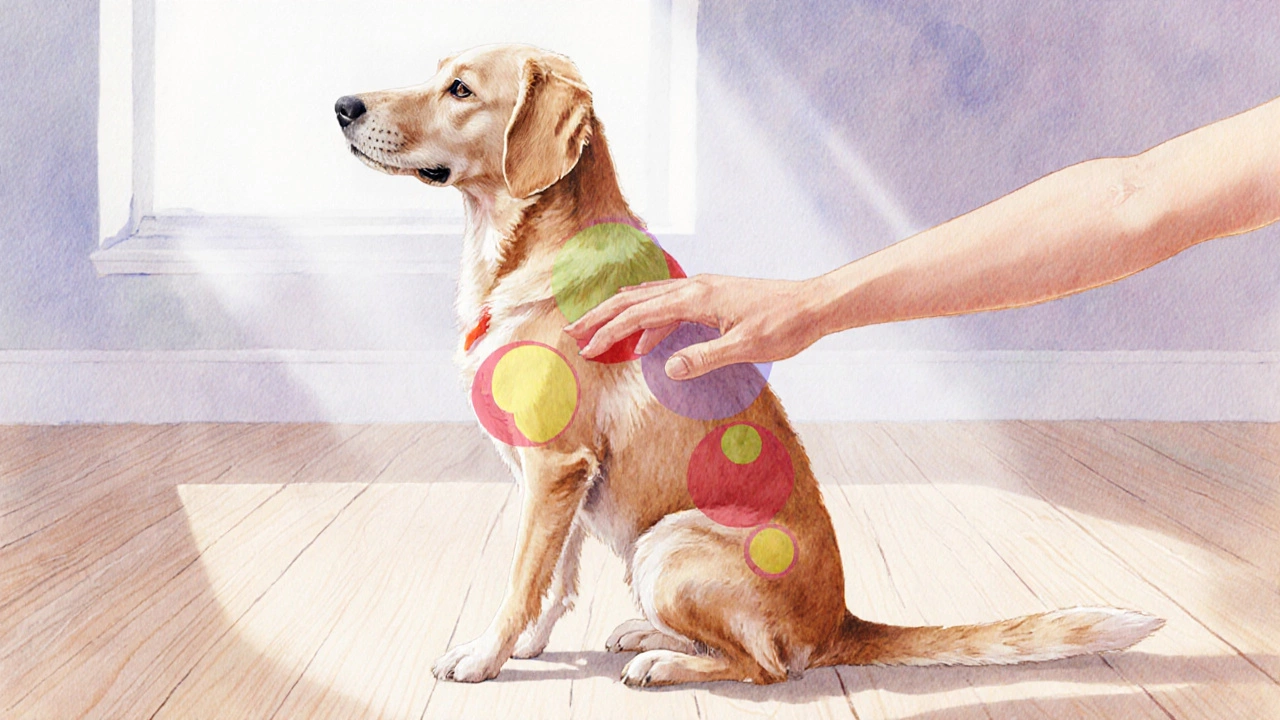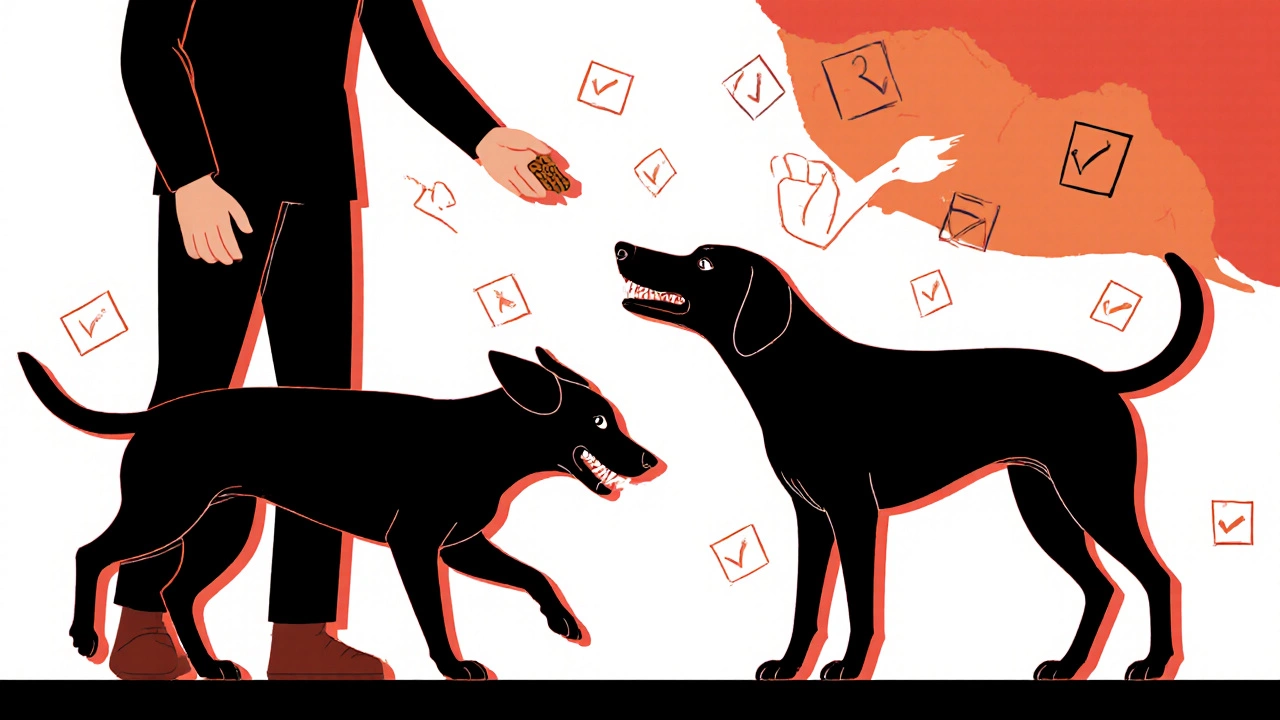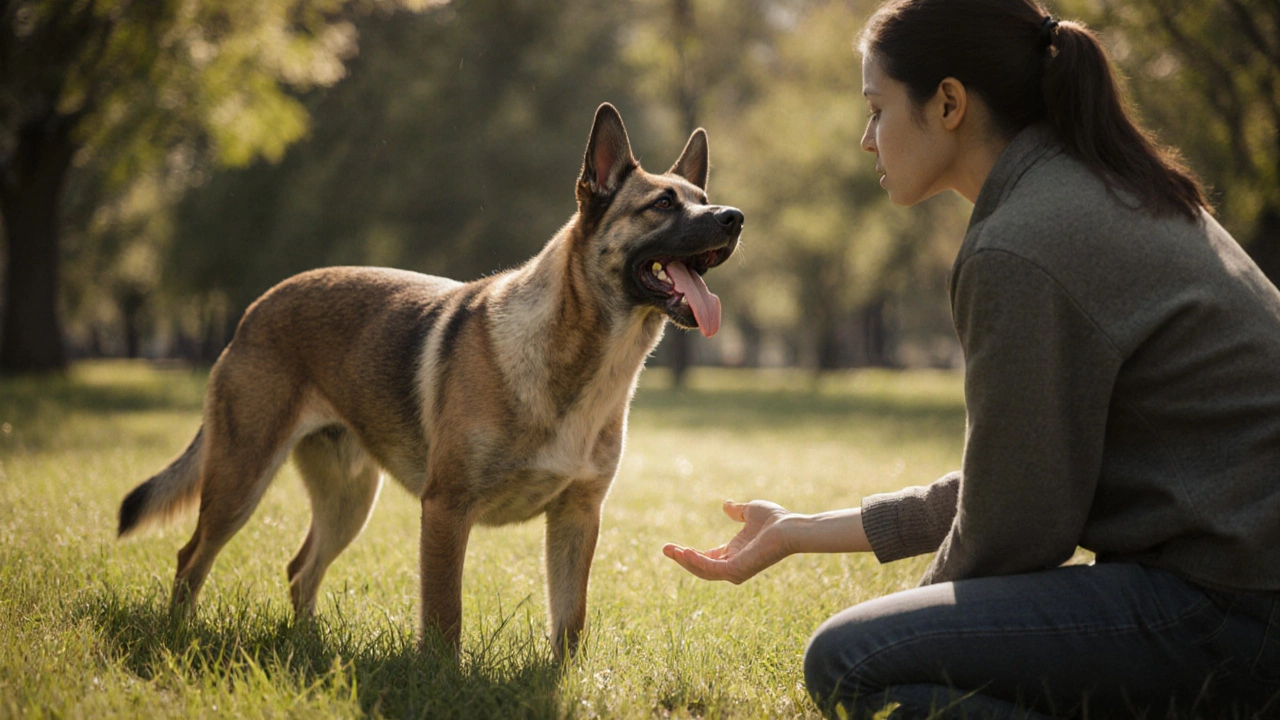Dog Petting Etiquette Checker
Select a body part and click "Check Safety Zone" to see information about petting etiquette.
Common Stress Signals to Watch For:
- Tucked tail
- Flattened ears
- Lip licking
- Stiff body posture
- Yawning or excessive panting
Ever tried to give a friendly pat and got a sudden growl, a stiff body, or a swift retreat? You probably just missed a clue about where dog petting is a no‑go. Knowing the right spots and the right moments can keep both you and the dog relaxed and happy.
Dog is a social animal that communicates feelings through posture, facial expression, and the parts of its body it allows you to touch. A Petting refers to the gentle, usually hand‑based contact people make with a dog’s fur or skin is only enjoyable when it aligns with the dog’s comfort zones.
The first step to respectful interaction is learning to read body language the set of visual signals a dog uses to show its emotional state. Misreading these signs leads to stress, and that stress shows up as clear stress signals such as a tucked tail, flattened ears, lip licking, or a sudden stiffening of the muscles. Understanding them lets you avoid the zones that trigger anxiety.
Below you’ll find the most common "don’t‑touch" spots, why they matter, and what safer alternatives exist for affection.
1. Head and Face - Only When Invited
Many dogs love a chin scratch, but the top of the head, ears, and muzzle are highly sensitive. A quick pat on the snout can feel like a threat because dogs protect their mouths instinctively.
- What to watch for: stiff neck, yawning, or a rapid turn away.
- Safe alternative: Wait for the dog to approach you and offer a gentle hand for a sniff before you start any contact.
2. Tail Base - The "Panic Button"
The base of the tail, just where it meets the back, is a pressure point. Dogs often use this area to express dominance or fear. A hand that rests there can be interpreted as a restraining gesture.
- What to watch for: tail tucking, rapid tail flicks, or a low‑growl.
- Safe alternative: Stroke the side of the chest or the ribs where the fur is softer and less nerve‑dense.
3. Belly - Not a Free‑For‑All
Exposing the belly is a sign of trust, but only if the dog rolls over voluntarily. Jumping straight to belly rubs before the dog offers this pose can be intimidating.
- What to watch for: tense abdominal muscles, a quick retreat, or a sudden snap.
- Safe alternative: Let the dog lie down first, then gently place your hand on the side of the torso and gauge the reaction.
4. Paws and Legs - Treat Them Like a Sensitive Spot
Paws are like hands for dogs - they’re used for feeling the ground and are often cleaned with their mouths. Touching them without permission can feel invasive.
- What to watch for: lifting a leg, shaking, or a sudden dart away.
- Safe alternative: If a vet or groomer needs to handle paws, they usually do it slowly while rewarding the dog; you can mimic this by offering a treat first.

5. Behind the Front Legs - The "Under‑Arm" Area
This region houses many muscles and can be a ticklish, painful spot for dogs with joint issues. Rubbing there can aggravate arthritis or hip dysplasia.
- What to watch for: a stiff gait, whimpering, or a hesitant step forward.
- Safe alternative: Stick to the chest or the neck area, which are less likely to cause discomfort.
6. During Specific Activities - Timing Matters
Even safe zones become off‑limits when a dog is eating, sleeping, or nursing puppies. Interruption at these moments can trigger defensive behavior.
- Eating: A hand near the bowl can be seen as competition; let the dog finish before you approach.
- Sleeping: A sudden touch can startle and provoke a bite; wait until the dog wakes naturally.
- Nursing puppies: Mother dogs are fiercely protective; keep distance unless you have explicit permission from the owner.
7. Breed‑Specific Sensitivities - Not All Dogs Are the Same
Some breeds have anatomical quirks that make certain areas more vulnerable. For example, Bulldogs often have skin folds that can become irritated, while Greyhounds have thin coats and delicate spines.
- Bulldog: Avoid heavy pressure on the neck folds; use light, short strokes.
- Greyhound: Keep hands away from the lower back where the vertebrae are close to the surface.
When in doubt, consult a veterinarian a trained medical professional for animals who can advise on safe handling and pain‑free touch points. A quick chat can save you a lot of awkward moments.
8. The Owner’s Role - Helping Your Dog Teach You
Owners are the best source of “where not to pet”. They know their dog’s history, past traumas, and favorite spots. A brief conversation can reveal that a dog was once rescued from a shelter where rough handling caused fear around the tail base.
- Ask: "Does your dog have any spots they don’t like to be touched?"
- Observe the dog’s reaction when the owner demonstrates a gentle pet.
- Follow the owner’s cues - they often give a hand signal or a word when the dog is uncomfortable.

Quick Reference Table
| Body Part | Why Avoid | Safe Alternative |
|---|---|---|
| Top of Head / Ears / Muzzle | Highly nerve‑dense; can feel threatening | Chin or side of neck after the dog initiates contact |
| Base of Tail | Pressure point linked to dominance and fear | Side ribs or chest |
| Belly (if not rolled over) | Dog may not be offering trust yet | Side torso once the dog lies down voluntarily |
| Paws / Legs | Sensitive, often cleaned with mouths; can be painful | Offer treat before any paw handling |
| Under‑arm area | Joint stress, especially in older dogs | Neck or upper back |
| During eating / sleeping / nursing | Interrupts essential behavior, triggers protectiveness | Wait for natural pause |
Repairing Trust After an Accidental Touch
If you accidentally pet a forbidden spot and the dog reacts negatively, don’t panic. Calmly step back, give the dog space, and let them approach you on their own terms. Offer a low‑value treat (like a small piece of kibble) to create a positive association with your presence again.
Consistency is key. Repeatedly respecting the dog’s boundaries trains them to trust you, and you’ll learn the subtle cues that tell you when it’s safe to pet.
Checklist for Respectful Dog Interaction
- Ask the owner about sensitive areas before approaching.
- Observe body language: relaxed posture, wagging tail, soft eyes = green light.
- Avoid head, tail base, paws, and under‑arm region unless the dog invites you.
- Never touch a dog while it’s eating, sleeping, or caring for puppies.
- If the dog shows stress signals, cease contact immediately.
- Reward calm behavior with treats or gentle praise.
Frequently Asked Questions
Can I pet a dog’s head if it leans into me?
If the dog actively leans forward, offers a sniff, and shows relaxed body language, a gentle chin or side‑neck pet is usually fine. Avoid the top of the head and muzzle unless the dog specifically nudges your hand there.
Why does my dog flare its ears when I try to rub its chest?
Ears can flare when a dog feels a sudden, unexpected touch near a sensitive spot. Move your hand to a broader, less nerve‑dense area like the side ribs and watch for a soft ear position as a sign of comfort.
Is it okay to pet a dog while it’s eating if I’m feeding it treats?
Generally no. Even if you intend to give a treat, a hand near the bowl can be perceived as competition. Offer the treat from a short distance after the dog finishes its meal.
My dog snarls when I try to pet its belly. What should I do?
A snarling belly indicates the dog isn’t ready to expose that vulnerable area. Step back, give the dog space, and try petting the chest or neck. When the dog rolls over on its own and shows a relaxed posture, then a belly rub is welcome.
Do all breeds have the same no‑pet zones?
The basic zones (head, tail base, paws) are common across breeds, but some breeds have extra sensitivities. For example, brachycephalic dogs (like Pugs) can have delicate facial skin, and large‑breasted breeds may have tighter skin near the ribs. Always consider breed‑specific anatomy and ask the owner.
